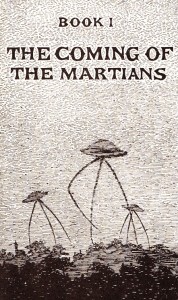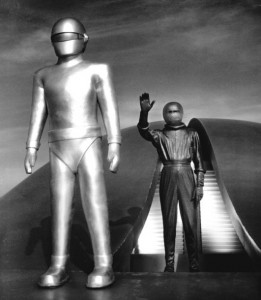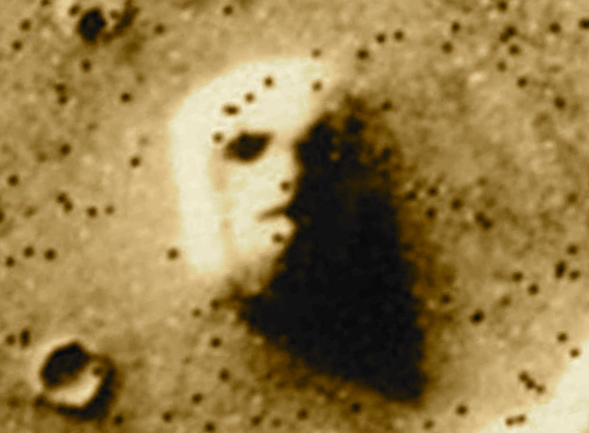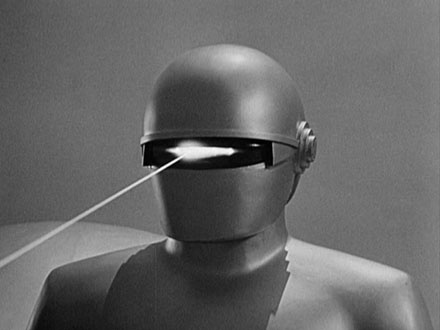Martian Holocausts, Cosmic Paranoia, and the Surveillance Universe
Ever since the Viking orbiters photographed a curiously face-like mountain and oddly pyramidal features in the Cydonia Mensae region of Mars in 1976, many have liked to speculate that the Red Planet was once inhabited, either by human settlers in the distant past—the argument made by Richard Hoagland—or by an indigenous civilization that flourished many hundreds of millions of years ago, when that planet was blue and green. Mac Tonnies summarized the claims (and counterarguments) in his excellent 2004 book After the Martian Apocalypse; now a recent book, Death on Mars
, provides an insider account of outsider Mars research, as well as offering a dark scenario about what might have befallen an ancient Martian civilization.
Based on various pieces of evidence including an anomalous excess of the isotope Xenon 129 in the Martian atmosphere, author John E. Brandenburg, a former NASA plasma physicist, makes the bold argument that the Red Planet’s inhabitants perished in a nuclear attack about half a billion years ago. He argues that they did not destroy themselves: Given the seemingly bronze-age technology of the Cydonia complex and other allegedly artificial features, Brandenburg argues that the bombs were lobbed from off-world—a possibility he finds chilling, since we have no idea of the motive for this holocaust, and whether we ourselves might be next.
The mind hates uncertainty, so it fills in the blanks with its own story, like a Rorschach inkblot, or like the frog DNA used to fill in the gaps of spotty dinosaur genome in Jurassic Park.
The evidence for nuclear detonation in Mars’s past is impossible for a non-specialist like me to evaluate, but the claims for the artificiality of the Cydonia face and its nearby “pyramids” is, unfortunately, highly tenuous at this point. Recent images of the “face” convincingly (to me) show a very un-face-like mesa. And the more anomalists claim to find “sacred geometry” and the like in the irregular angles of the nearby “pyramid complex,” the more I am reminded of other obsessive Forteans who somehow distinctly see Sasquatches in every forest shadow and orb-like spirits of the dead in the lens flare of their photographs.
Pareidolia is seeing patterns, meaningful information, in what is probably noise. It particularly haunts various anomalistic fields, because they concern mysterious phenomena for which data are patchy at best. The mind hates uncertainty, so it fills in the blanks with its own story, like a Rorschach inkblot, or like the frog DNA used to fill in the gaps of spotty dinosaur genome in Jurassic Park. For instance, while anyone could be forgiven for seeing a face in the original low-res Cydonia images taken by the Viking orbiters, many of ur-anomalist Richard Hoagland’s other “discoveries” on Mars and elsewhere in the solar system, such as giant crystal domes and latticework he claims to see in Apollo lunar photographs, veer well into sad/laughable territory.
Brandenburg dwells too heavily on the Cydonia face and many lesser, even less convincing face-like features, but on the whole his argument is less outrageous than some of Hoagland’s conjectures. Other parts of his book, such as his discussion of the contentious evidence for microfossils in Martian meteorites, and even the personal narrative in which his argument is embedded, are actually quite interesting. So is his only somewhat paranoid-seeming argument why we should be distrustful of NASA’s contractor Jet Propulsion Laboratory (JPL). The argument will be familiar to readers of Tonnies’ 2004 book, but Tonnies was drawing there on Brandenburg’s earlier work.
JPL’s speciality has always been robotic exploration, thus it has a vested interest (Brandenburg claims) in promoting Mars as mainly an object of geological, not biological (let alone anthropological), interest. Discovery of life or, even more significantly, the remains of a civilization, would very quickly turn Mars into an urgent destination for human missions and thus challenge JPL’s monopoly on planetary exploration. It is noteworthy that the only Martian landers ever to carry actual life-detecting experiments were Vikings 1 and 2, and the results—which actually tipped in favor of the presence of microbial life—resulted in endless bitter contention among planetary scientists. Whether it is to avoid further insoluble disputes or really reflects the “dead Mars” preference of JPL, subsequent missions, including the Curiosity rover currently surveying the base of Aeolus Mons (“Mount Sharp”), have had no ability to test for life in the Martian soil.
 When Viking’s low-res images were supplanted by higher-resolution images in the late 1990s that seemed to dispel the face’s faceyness, the Mars anomaly community claimed the images had been deliberately manipulated by JPL or its image subcontractor Malin Space Science Systems, as part of a coverup to keep the Red planet dead. While I would prefer to think any bias against detecting life has more likely guided JPL tacitly and institutionally rather than deliberately and conspiratorially, in 2004 Hoagland exposed a troubling case of what could only be called serious negligence if it was not indeed part of a coverup: The Opportunity rover photographed a feature looking very much like a terrestrial crinoid fossil (left), and instead of examining it more closely, promptly sanded the feature into oblivion with its “rock abrasion tool.” (The original before and after photos can be seen here.) The ways four decades of interplanetary exploration may have been shaped by specific scientific assumptions that just happen to keep JPL’s contract with NASA secure seem to be a possibly important story awaiting investigation by some enterprising (and unbiased) space science journalist.
When Viking’s low-res images were supplanted by higher-resolution images in the late 1990s that seemed to dispel the face’s faceyness, the Mars anomaly community claimed the images had been deliberately manipulated by JPL or its image subcontractor Malin Space Science Systems, as part of a coverup to keep the Red planet dead. While I would prefer to think any bias against detecting life has more likely guided JPL tacitly and institutionally rather than deliberately and conspiratorially, in 2004 Hoagland exposed a troubling case of what could only be called serious negligence if it was not indeed part of a coverup: The Opportunity rover photographed a feature looking very much like a terrestrial crinoid fossil (left), and instead of examining it more closely, promptly sanded the feature into oblivion with its “rock abrasion tool.” (The original before and after photos can be seen here.) The ways four decades of interplanetary exploration may have been shaped by specific scientific assumptions that just happen to keep JPL’s contract with NASA secure seem to be a possibly important story awaiting investigation by some enterprising (and unbiased) space science journalist.
Dead and Red: The Martian Imaginal
Paranoia and pareidolia go hand in hand. Mars anomalistics is only the latest phase in what could be called the Martian imaginal—the tendency to make the Red Planet into a projection screen for our hopes and, more frequently, fears (and, in JPL’s case perhaps, financial interests). It goes back to Perceval Lowell’s canals, HG Wells’ War of the Worlds, and numerous other lesser-known touchstones. Whether or not it is because of the planet’s symbolic past and astrological significance, war and death have often played a big role in this imaginal.
Brandenburg’s Herod-style slaughter of the Martian innocent “as an attempt to prevent the birth of Christ in this solar system” is the most creative motive I’ve read for interstellar genocide.
Brandenburg places his research on an ancient inhabited Mars and its subsequent death within the context of the Cold War and his own perspective as a physicist involved directly in researching energy weapons for possible use in missile defense. For him, the evidence of a Martian nuclear holocaust was a chilling warning, both that the Superpowers needed to end the insane arms race and that, as a human imperative, we urgently needed to launch a manned mission to Mars to investigate what happened on that planet. Although more cautious of the evidence for Martian inhabitation, Carl Sagan was a supporter of this vision. Indeed it was thanks to Sagan’s enormous scientific imagination that Mars and Venus, our neighboring worlds, became object lessons for the major Democratic causes of late- and post-Cold War America: nuclear disarmament and climate change, respectively. Venus’s rampant greenhouse effect showed us what Earth could turn into if we don’t rein in our emission of greenhouse gases; and Sagan used dust storms on Mars to illustrate the scary notion of nuclear winter, a frigid life-eradicating darkness that would ensue after multiple bomb detonations.
 Much to Brandenburg’s credit, he does not harbor the antipathy to Sagan that many anomalists and Forteans do, reminding us that Sagan himself was open-minded about the possibility of an ancient Martian civilization, even if he appeared closed-minded on other areas with much better evidence, like UFOs. I’ve argued before that Sagan’s skepticism toward UFOs may have reflected his own kind of cosmic imaginal, which actually served a wise social/political agenda: A vast universe with distant intelligences and perhaps ancient relics of ET visitation on Mars or the Moon was a sublime vision that went hand in hand with taking responsibility for our cosmic fate and the fate of our planet, rather than expecting benevolent intervention by flying saucer brethren buzzing around our solar system in the here and now.
Much to Brandenburg’s credit, he does not harbor the antipathy to Sagan that many anomalists and Forteans do, reminding us that Sagan himself was open-minded about the possibility of an ancient Martian civilization, even if he appeared closed-minded on other areas with much better evidence, like UFOs. I’ve argued before that Sagan’s skepticism toward UFOs may have reflected his own kind of cosmic imaginal, which actually served a wise social/political agenda: A vast universe with distant intelligences and perhaps ancient relics of ET visitation on Mars or the Moon was a sublime vision that went hand in hand with taking responsibility for our cosmic fate and the fate of our planet, rather than expecting benevolent intervention by flying saucer brethren buzzing around our solar system in the here and now.
Brandenburg’s own Martian imaginal, although entertaining and based on some interesting evidence, is way too speculative to take very seriously. He also concedes it is grounded partly in his religious beliefs. Near the end of the book, he offers an admittedly “emotional conjecture” that “this Solar system may have been prophesied to be the home of the Christ by other species in space, and perhaps became a target because of it.” Brandenburg is not writing science fiction, but his Herod-style slaughter of the Martian innocent “as an attempt to prevent the birth of Christ in this solar system” is surely the most creative motive I’ve read for interstellar genocide. However, no less a mind than Stephen Hawking has also waxed alarmist at the prospect of ET aggression, suggesting we should make no attempts to advertise our presence lest we invite invasion or destruction. Are such fears realistic?
A Requiem for Alderaan
While it is often justified in religious terms, human aggression always boils down ultimately to competition for valuable resources and to self-defense. This fact itself is, I believe, one of the biggest counterarguments to most “hostile ET” scenarios.
All sci-fi scenarios for planetary destruction—including pure paranoid insanity—are predicated on an absence of the one thing I suspect the universe is actually full of: knowledge.
ET civilizations with the mastery of energy and matter on the scale required for extensive interstellar travel (i.e., Type I or Type II Civilizations, let alone higher) will have long since solved any resource problems that we or our planet’s (or even solar system’s) resources could help them with. Earth is truly, as Sagan underscored, a miniscule blue spec. Our minerals, our water, our meat, and our nice attractive real estate, dearly precious to us, will offer ETs nothing they can’t manufacture for themselves via sidereal and planetary engineering. Given the wild dissinchrony that will obtain between different intelligent races/civilizations/post-civilizations in our galaxy, anybody out there capable of becoming aware of us is in all probability already living in massive Dyson pleasure spheres, or has transcended physical reality altogether, if they are not long dead and gone. Whatever the case, they’re not in a position to want anything from us. Nor are they in a position to feel terribly threatened either by our presence or by our weapons (including our secret weapon, Jesus).
 Yet the assumption that advanced ETs could simply be malicious or have some other nefarious or unfathomable motive to destroy young civilizations like ours is a widely held one, and is of course a sci-fi staple. For example, Alastair Reynolds’ Revelation Space series is premised upon the discovery of civilization-destroying booby traps placed billions of years ago by an ancient race called the Inhibitors. Their purpose is to cull emerging civilizations throughout the galaxy in order to make galactic engineering easier when Andromeda and the Milky Way collide in another 3 billion years. Although I mostly love Reynolds’ imagination, this ancient agenda—sort of the opposite of that of the slabs in Arthur C Clarke’s 2001—falls flat. Not only does it seem like rather insane and pointless cosmic stewardship, it also (I assume unintentionally) calls to mind Douglas Adams’ comical scenario in Hitchhiker’s Guide to the Galaxy: destroying Earth to make way for a cosmic express route.
Yet the assumption that advanced ETs could simply be malicious or have some other nefarious or unfathomable motive to destroy young civilizations like ours is a widely held one, and is of course a sci-fi staple. For example, Alastair Reynolds’ Revelation Space series is premised upon the discovery of civilization-destroying booby traps placed billions of years ago by an ancient race called the Inhibitors. Their purpose is to cull emerging civilizations throughout the galaxy in order to make galactic engineering easier when Andromeda and the Milky Way collide in another 3 billion years. Although I mostly love Reynolds’ imagination, this ancient agenda—sort of the opposite of that of the slabs in Arthur C Clarke’s 2001—falls flat. Not only does it seem like rather insane and pointless cosmic stewardship, it also (I assume unintentionally) calls to mind Douglas Adams’ comical scenario in Hitchhiker’s Guide to the Galaxy: destroying Earth to make way for a cosmic express route.
More worthy of consideration is the motive for preemptive genocide that serves as the premise of a bad-but-interesting 1995 novel called The Killing Star, by Charles Pellegrino and George Zebrowski. A race of coldly logical alien octopi completely obliterate Earth and all human outposts in the solar system, without warning, using relativistic missiles—self-guided projectiles traveling at velocities edging toward the speed of light. The octopi’s motive is that they detect from our TV broadcasts (including Star Trek) that our species is on the brink of acquiring the technical capacity for relativistic spaceflight, so could potentially create a relativistic missile ourselves. Their attack is a preemptive strike just to be on the safe side.
Advanced ETs won’t look out into space the way we still do, seeing darkness and mystery and potential threats. Their technology will have created for them a cosmos of light, a noöverse.
The basic (and interesting) idea here is that relativistic spaceflight is itself the deadliest of weapons: An object accelerated to an appreciable percent of lightspeed would have kinetic energy well in excess of an equivalent amount of antimatter, and thus be practically the most destructive thing imaginable. Forget nuclear weapons; no warheads are needed. Also, such an attack would also be impossible to see coming. Applying this logic to SETI, the authors of The Killing Star suggest that the Great Silence (Fermi Paradox) may reflect not that civilizations destroy themselves but rather that they destroy each other: Specifically, whoever in our galaxy first acquired relativistic capability went ahead and suppressed all other newly arising civilizations with swift, planet-killing bullets to assure their own safety.
This is a distinctly Cold War logic, reminiscent of what was surely going through the minds of some strategists who were tasked with thinking the unthinkable: namely, preemptive strikes to eliminate the nuclear threat posed by Russia and China. It is an important argument to consider as an answer to the Fermi Paradox; but we also need to look at the geopolitical world that replaced the Cold War, and perhaps project newer (and ideally, future) realities onto the night sky instead of outmoded Dr. Strangelove fantasies. All the various sci-fi scenarios for planetary destruction, from the (weirdly) custodial motives of Reynolds’ Inhibitors to the purely survival imperative of Pellegrino and Zebrowski’s octopi—and even, pure paranoid insanity—are predicated on an absence of the one thing I suspect the universe is actually full of: knowledge, produced by ongoing active machine surveillance on a planet-to-planet level.
It’s a Noöverse, Folks
If ETs exist at all, the math dictates that “they” are already aware of us and were aware of us long before we started setting off nuclear warheads and long before they started receiving our broadcasts of Star Trek and I Love Lucy. ET surveillance drones could have been here before we stood upright on the savannah, and likely even before the primordial oceans bloomed with algae. This should not be a scary thought, but a reassuring one: A vast active drone intelligence system operating quietly across million- and billion-year timespans, which I have argued is probably the inevitable project of advanced civilizations, eliminates the kinds of scenario favored in space operas or cosmic paranoia scenarios like The Killing Star.
Klaatu is a myth we should, as thoughtful adults, grow out of. I’m here to tell you, though, that there are probably lots and lots of very unobtrusive Gorts.
Paranoia takes over in the absence of noös, knowledge and knowing. When you don’t know what’s out there, you fear it. Advanced ETs won’t look out into space the way we still do, seeing darkness and mystery and potential threats. Their technology will have created for them a cosmos of light, a noöverse, that they can inhabit virtually and that supplies them (or their machine proxies) with godlike prediction-and-control capacity. If, through a massive stealthy automated program of deep anthropology, you have complete predictive power over any and all ‘lesser’ species and civilizations, you—or really, your machine proxies—have ample warning to intervene in subtle, non-drastic ways to ensure your long-term safety. Emerging threats such as new spacefaring warlike civilizations and imminent supernovas (not to mention galactic collisions) will be foreseen long in advance, enabling easy steps to prevent calamity—rather like an ocean liner making a gentle, minor course correction ten miles away from an iceberg instead of a panicked course correction a half mile away. Swarming the galaxy with a neural net of autonomous Von Neumann probes capable of nuanced cultural intervention would require far less expenditure of energy and resources than accelerating projectiles to relativistic velocities. Surveillance and control in this subtle, long-duration sense will, I suspect, have largely replaced weapons and warfare for the universe’s more mature (and ancient) inhabitants.
The argument that the universe is really a noöverse can be made solely based on the Drake Equation and various mathematical models of interstellar expansion and Von Neumann probe propogation. Yet, two pieces of the UFO puzzle harmonize rather nicely with it: One is Vallee’s “control system” hypothesis—the notion that whoever/whatever is behind the UFO phenomenon, they seem to be steering us or nudging us somehow. Although Vallee favors a more local or interdimensional origin for these phenomena, a very long term project of subtle cultural course corrections coupled with a program of deep anthropology fits well with an ET drone hypothesis too, as I’ve argued previously. (Personally I suspect that the UFO phenomenon is actually multiple separate phenomena, including some ET component and a more local or interdimensional one, and that lumping them together contributes to our bafflement.)
 The other puzzle piece is UFOs’ overt and well-documented interest in nuclear weapons, noted by various authors including Leslie Kean
The other puzzle piece is UFOs’ overt and well-documented interest in nuclear weapons, noted by various authors including Leslie Kean and evidenced by Robert Hastings’ impressive body of data on UFO encounters in the context of nuclear tests and at missile silos. The notion that ET is here to steer us away from using nuclear weapons has of course been a staple of UFO folklore and popular culture from the start—most famously, the 1951 classic The Day the Earth Stood Still. Just because it’s pop culture doesn’t mean it’s wrong. My only modification to this scenario is that ET “interest” in our military technology would be very long-term and would not at all be personal: Klaatu is a myth we should, as thoughtful adults, grow out of. I’m here to tell you, though, that there are probably lots and lots of very unobtrusive Gorts.
Postscript: Surveillance States
In the noöverse, we have no expectation of privacy. When our galactic antecedents could be millions or billions of years beyond us in technological capacity, being surreptitiously watched by them and even nudged culturally should be a reassuring prospect, not a disturbing one. What about affairs closer to home, when advanced technological states are, sort of similarly, light years beyond their citizenry in technological capacity? Considerations and reconsiderations of cosmic paranoia should force us to reflect on more immediate political realities.
If a paranoid military-government apparatus lacked the technological ability to listen to its citizens’ phone calls and read its e-mails, might it not feel compelled to engage in a more widespread pattern of imprisonment, torture, and assassination?
Much as I applaud Edward Snowden and others who are reporting on and fighting the encroachment of the modern secrecy/surveillance state, I think it is also useful to at least consider how a situation of pervasive surveillance might actually be preferable to certain alternatives in our current “archonic” terrestrial reality. Before you hurl tomatoes at me, listen: If a paranoid military-government apparatus lacked the technological ability to listen to its citizens’ phone calls and read its e-mails, might it not feel compelled to engage in a more widespread pattern of imprisonment, torture, and assassination of people even remotely fitting the profile of a subversive or terrorist?
In other words, state surveillance is worse than privacy, but it may be better than other possibilities we generally avoid thinking about—like a pattern of outright, stealthy killing and “disappearances.” While I suppose it could reflect a passive, cowardly cynicism about political structures and governments, part of me wonders whether high-tech state surveillance, by reducing state-level paranoia, might actually make make us safer from those governments, if not actually safer from ostensible external threats like terrorism. I don’t know the answer, but I put that out there for consideration and discussion.







Regarding your assertion about government surveillance serving to reduce the paranoia of the state, and curtail its abusive behavior — I don’t believe human (or worse yet, organizational) minds could sufficiently process and correlate all that data to truly develop an understanding of it that would head off paranoia and appropriately target action. To do so would require either that the state rely on an array of highly advanced AIs that it trusts implicitly, or for the state to be such an AI.
In the real world, I don’t believe the surveillance apparatus is substantively engaged in risk assessment at all. Rather it works to build a database from which data can be cherry picked to support whatever policy or prosecutions (initiated on more traditional, and often corrupt, bases) the controllers seek to support. It feeds and supports the pattern of ham-handed, paranoia-driven, profiling-based tyranny you describe, rather than supplanting it.
And in the event AIs could be created that could apprehend such a breadth of data, I’m skeptical that they would be truly reliable or trustworthy. Wouldn’t they be as flawed as their programming in assessing the meaning and weighting of the data they analyze? Wouldn’t they be inclined to view 100 “false positives” as an acceptable price for saving 101 lives?
I don’t fault your question as a thought exercise, but I think it ends up in the same trap as speculation about digitized law enforcement and justice generally — it presupposes a completeness and perfection in the collection and handling of information that is unattainable in the material world.